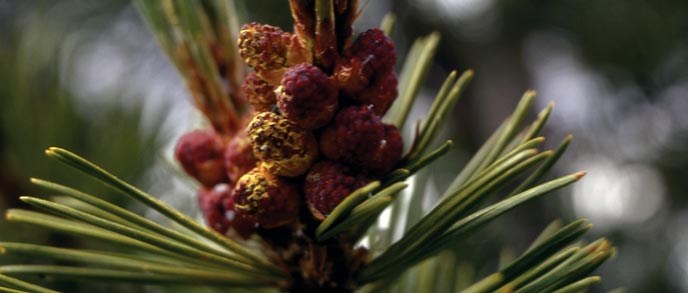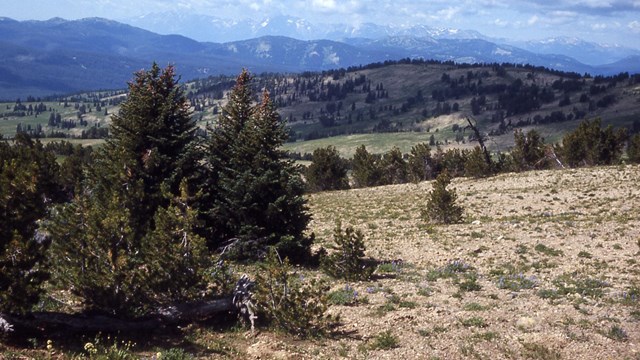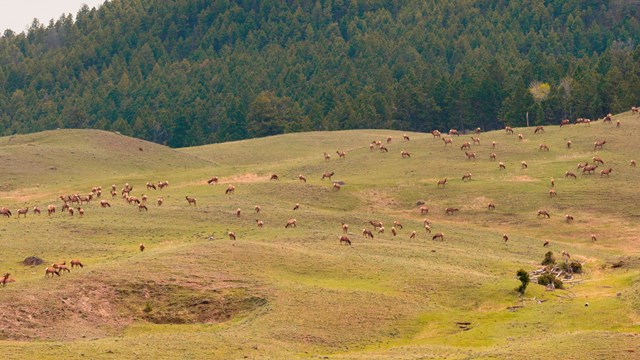
NPS / Jim Peaco Forests cover roughly 80% of the park. Lodgepole pine, Engelmann spruce, subalpine fir, whitebark pine, and limber pine are found at higher elevations. Though ubiquitous throughout the park, Douglas-fir is particularly abundant in the northern region. Their thick bark enable them to tolerate low-intensity fire. Some of the trees in these forests are estimated to be several hundred years old and display fire scars from a past history of low-intensity ground fires. In contrast, lodgepole pine trees have very thin bark which makes this species more susceptible to mortality from ground fires. In high elevation areas where andesite, a type of volcanic rock, is prevalent, older forests are dominated by Engelmann spruce and subalpine fir. In the past, these current spruce/fir forests may have been dominated by lodgepole pine but in the absence of fire, Engelmann spruce and subalpine fir were able to dominate and thrive. In forests dominated by lodgepole pine, Engelmann spruce and subalpine fir can be a common a forest understory component. Lodgepole is dominant on rhyolitic soils which are poor in nutrients essential for fir and spruce. At higher elevations such as the Absaroka Mountains and the Washburn Range, whitebark pine is a significant forest component. In the upper subalpine zone, whitebark pine, Engelmann spruce, and subalpine fir often co-occur in island stands of timber separated by subalpine meadows. In treeline environments where conditions are extreme, whitebark pine take on a stunted growth form known as krumholtz where most of the “tree” is protected below the snow from winter’s wind and desiccating effects. Lodgepole PineThe lodgepole pine (Pinus contorta) is by far the most common tree in Yellowstone. Early botanical explorers first encountered the species along the West Coast where it is often contorted into a twisted tree by the wind, and thus named it Pinus contorta var. contorta. The Rocky Mountain variety, which grows very straight, is Pinus contorta var. latifolia. Some American Indian tribes used this tree to make the frames of their tipis or lodges, hence the name “lodgepole” pine. DescriptionLodgepoles are the only pine in Yellowstone whose needles grow in groups of two. The bark is typically somewhat brown to yellowish, but a grayish-black fungus often grows on the shady parts of the bark, giving the tree a dark cast. The species is shade intolerant; any branches left in the shade below the canopy will wither and fall off the tree. Lodgepoles growing individually, often support branches to the base of the trunk due to full-tree exposure to sunlight. ReproductionLike all conifers, lodgepole pines have both male and female cones. The male cones produce huge quantities of yellow pollen in June and July. This yellow pollen is often seen in pools of rainwater around the park or at the edges of lakes and ponds. The lodgepole’s female cone takes two years to mature. In the first summer, the immature cones look like tiny, ruby-red miniature cones near the end of the branches. The following year, after fertilization, the cone starts to grow rapidly and turns a conspicuous green hue. Female cones will either open at maturity and subsequently release their seeds, or they remain closed. Cones that remain closed—a state known as serotiny—can hang on the branches for years until they are subjected to high heat such as a forest fire. Within a short period of time after the tree ignites, the cones open, seeds are released over the charred area, and the forest has been in effect, replanted. Trees without serotinous cones (Engelmann spruce, subalpine fir, and Douglas-fir) must rely on wind, animals, or other agents to carry seeds into recently burned areas. HabitatLodgepole pines prefer slightly acidic soil, and will grow quickly in mineral soils disturbed by fire or by humans, such as where a road has been cut into the forest. Their roots spread out sideways and do not extend deeply into the soil—an advantage in Yellowstone where the topsoil is only about 6 to 12 inches deep, but a disadvantage in high winds. Lodgepole pines are vulnerable in windstorms, especially individuals that are isolated or in the open.. In addition to their ability to reseed effectively after disturbance, lodgepole pines can grow in conditions ranging from very wet ground to very poor soil prevalent within the Yellowstone Caldera. This flexibility allows the species to occur in habitats that otherwise would not be forested. Because lodgepole pines are dependent on sunny conditions for seedling establishment and survival, the trees do not reproduce well until the canopy opens up significantly. In the Yellowstone region, this allows the lodgepole pine forest to be replaced by shade-loving seedlings of subalpine fir and Engelmann spruce where the soil is well-developed enough to support either of these species. In areas of nutrient-poor soil, where Engelmann spruce and subalpine fir struggle, lodgepole pines will eventually be replaced by more lodgepole pine trees as the forest finally opens enough to allow young lodgepoles to become established. 
NPS Whitebark PineWhitebark pine (Pinus albicaulis) occurs at high elevations a in subalpine communities in the northern Rocky Mountains and the Pacific Northwest. It often grows in areas with poor soils, high winds, and steep slopes that are inhospitable to other tree species. White bark pine is a key species in these upper ranges where it retains snow and reduces erosion, acts as a nurse plant for other subalpine species, and produces seeds that are an important food for birds, grizzly bears, and other wildlife. Whitebark pine produces wingless seeds and relies primarily on Clark’s nutcrackers (Nucifraga Columbiana) for seed dispersal. Substantial mortality in whitebark populations has been documented throughout its range. Decreases are attributed to the introduced pathogen, white pine blister rust (Cronartium ribicola); native mountain pine beetle (Dendroctonus ponderosae); historic wildland fire suppression resulting in more frequent, larger, and hotter wildfires; and projected environmental factors associated with climate change. These agents, both individually and collectively, pose a significant threat to the persistence of healthy whitebark pine populations on the landscape. As of 2019, 1,728 of the more than 5,300 monitored trees had died, including 64% of those in the >10 cm in diameter size classes. (The mountain pine beetle prefers larger trees for laying their eggs; the larvae feed on the inner phloem of the bark.) In addition, the Greater Yellowstone Network has estimated that by the end of 2015, 26% of whitebark pine trees >1.4 meters tall had died. Aerial surveys, which measure the spatial extent of mortality rather than the percentage of individual dead trees counted on the ground, have generally produced higher whitebark pine mortality estimates in the Greater Yellowstone Ecosystem. This could be because larger trees, which occupy more of the area in the forest canopy visible from the air, are more likely to be attacked by beetles. In 2013, an aerial survey method called the Landscape Assessment System was used to assess mountain pine beetle-caused mortality of whitebark pine across the region. Results of the one-time study indicate that nearly half (46%) of the GYE whitebark pine distribution showed severe mortality, 36% showed moderate mortality, 13% showed low mortality, and 5% showed trace levels of mortality. Despite the high percentage of large trees that have died, there are trees that are still producing cones and regeneration is occurring. The network estimated an average growth of 51 small trees per 500 meters squared by the end of 2015. Understory VegetationUnderstory vegetation differs according to precipitation, the forest type, and the substrate. Lodgepole pine forest is often characterized by a very sparse understory of mostly elk sedge (Carex geyeri) or grouse whortleberry (Vaccinium scoparium). Pinegrass (Calamagrostis rubescens) occurs frequently under Douglas-fir forest but is also common under other forest types, especially where the soil is better developed or more moist. In some areas of the park, such as Bechler and around the edges of the northern range, a more obviously developed shrub layer is composed of species such as Utah honeysuckle (Lonicera utahensis), snowberry (Symphoricarpos spp.), and buffaloberry (Shepherdia canadensis). Forest Insect PestsConiferous trees of Yellowstone currently face one fungal and five insect threats. The fungus is a nonnative species while the insects are native to this ecosystem. Both fungus and insects have been present and active in cycles, probably for centuries. A scientist studying lake cores from the park has found some of their insect remains in the cores, indicating their existence even millions of years ago. However, in the last 10 years, all five insects have been extremely active as a result of climate change. The primary cause of tree mortality in Yellowstone is native bark beetles. Beetles damage trees in similar ways: their larvae and adults consume the inner bark. If the tree is girdled, it dies. Their feeding activity can girdle a tree in one summer, turning the crown red by the following summer. The needles usually drop within the next year, leaving a standing dead tree. The isolated pockets of red-needled trees scattered throughout the park lend testament to beetle activity. Pest ActivityThe severity of insect-caused tree mortality has been considerable throughout the West for over a decade, and these damaging insects have spread to previously unaffected plant communities. Several native bark beetle species in the Scolytidae family have altered extensive areas within Greater Yellowstone. Forest structure, tree health, and climate are the major factors in determining whether an outbreak expands; drought and warmer temperatures can make forests more vulnerable to infestation. Although activity by both Douglas-fir beetle and Engelmann spruce beetle has declined to endemic (natural to Yellowstone) levels since 2000, other forest insects of ecological significance remain active. Mountain pine beetle activity was largely confined to the northwest portion of the park, in high-elevation whitebark pine and lower-elevation lodgepole pine, peaking in 2009 with annual decreases in mortality since then. Defoliation of Douglas-fir and Engelmann spruce by the western spruce budworm is present in the park throughout the lower Lamar and along the Yellowstone and Lamar river valleys, but has spread considerably less in recent years. These trends appeared to continue in 2011, when the park was only partially surveyed. Future of Insect Outbreaks in YellowstoneLandscape-scale drought and the availability of suitable host trees have contributed to the initiation and persistence of insect outbreaks. Healthy trees can defend themselves from beetle attack by “pitching out” adult females as they try to bore into the tree. Extreme winter temperatures can kill off overwintering broods, and wet summer weather impedes the insects from invading additional trees. Insect activity also decreases as the larger and more susceptible trees are killed off. Spruce beetles have declined because they have killed almost all of their preferred food source (spruce trees more than 10 inches in diameter). Recent and ongoing studies supported by the National Park Service are investigating the interaction between insect infestations and wildfire. Researchers have focused on how bark beetle epidemics may affect fire behavior in lodgepole-dominated forests and are comparing the resulting fire hazard with that in Douglas-fir forests. Forest-related ArticlesSource: NPS DataStore Collection 7855. To search for additional information, visit the NPS DataStore. Source: NPS DataStore Collection 7857. To search for additional information, visit the NPS DataStore. 
Vegetation & Resources Management Branch
Park employees who inventory, monitor, manage, and research the vast array of plant communities in the park. 
Plants
Spring is a time for plant growth, fueling the return of many migratory species. |
Last updated: April 18, 2025
